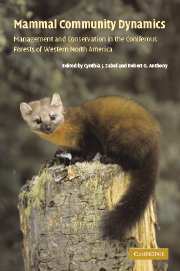 Mammal Community Dynamics
Mammal Community Dynamics Book contents
- Frontmatter
- Contents
- List of contributors
- Foreword
- Acknowledgments
- Part I Management and conservation issues for various taxa
- 1 Introduction and historical perspective
- 2 Forests and woodlands of western North America
- 3 Faunal composition and distribution of mammals in western coniferous forests
- 4 Habitat ecology and conservation of bats in western coniferous forests
- 5 Ecological relationships of terrestrial small mammals in western coniferous forests
- 6 Ecology and conservation of arboreal rodents of western coniferous forests
- 7 Small and mid-sized carnivores
- 8 Ecology, conservation, and restoration of large carnivores in western North America
- 9 Ungulates in western coniferous forests: habitat relationships, population dynamics, and ecosystem processes
- Part II Community and ecosystem relations
- Part III Conservation issues and strategies
- Index
- References
7 - Small and mid-sized carnivores
Published online by Cambridge University Press: 15 December 2009
- Frontmatter
- Contents
- List of contributors
- Foreword
- Acknowledgments
- Part I Management and conservation issues for various taxa
- 1 Introduction and historical perspective
- 2 Forests and woodlands of western North America
- 3 Faunal composition and distribution of mammals in western coniferous forests
- 4 Habitat ecology and conservation of bats in western coniferous forests
- 5 Ecological relationships of terrestrial small mammals in western coniferous forests
- 6 Ecology and conservation of arboreal rodents of western coniferous forests
- 7 Small and mid-sized carnivores
- 8 Ecology, conservation, and restoration of large carnivores in western North America
- 9 Ungulates in western coniferous forests: habitat relationships, population dynamics, and ecosystem processes
- Part II Community and ecosystem relations
- Part III Conservation issues and strategies
- Index
- References
Summary
The small and mid-sized carnivores (Carnivora), or mesocarnivores of western forests comprise 16 species (coyote (Canis latrans), red fox (Vulpes vulpes), gray fox (Urocyon cinereoargenteus), ringtail (Bassariscus astutus), raccoon (Procyon lotor), marten (Martes americana), fisher (M. pennanti), ermine (Mustela erminea), long-tailed weasel (M. frenata), mink (M. vison), wolverine (Gulo gulo), northern river otter (Lontra canadensis), western spotted skunk (Spilogale gracilis), striped skunk (Mephitis mephitis), Canadian lynx (Lynx canadensis), and bobcat (Lynx rufus)). The term “forest carnivores” denotes a smaller group of four species – the marten, fisher, lynx, and wolverine – and is only marginally descriptive, inasmuch as it excludes many carnivores that live in forests, and includes the wolverine, which can thrive in the complete absence of trees. The species we consider here represent four (or five (Dragoo and Honeycutt 1997)) taxonomic families and are characterized by adult body weights typically <20 kg. Other mesocarnivores, including the kit fox (Vulpes macrotis), swift fox (V. velox), least weasel (Mustela nivalis), black-footed ferret (M. nigripes), and badger (Taxidea taxus), occur in the West, occupy habitats near forest edges, and may be conservation concerns. However, they are plains or grassland specialists or, in the case of the least weasel, very poorly known, and cannot be characterized in terms of their needs for forest attributes. So, they are not treated here.
Our understanding of the ecology of carnivores in western coniferous forests varies markedly.
- Type
- Chapter
- Information
- Mammal Community DynamicsManagement and Conservation in the Coniferous Forests of Western North America, pp. 207 - 249Publisher: Cambridge University PressPrint publication year: 2003
References
- 22
- Cited by


